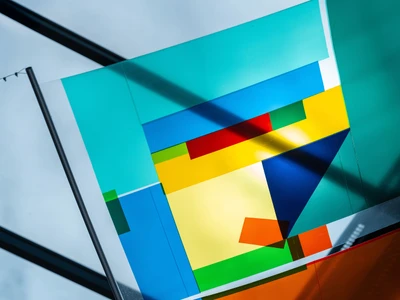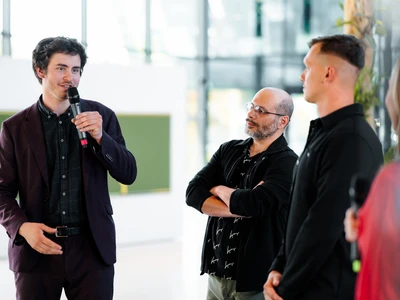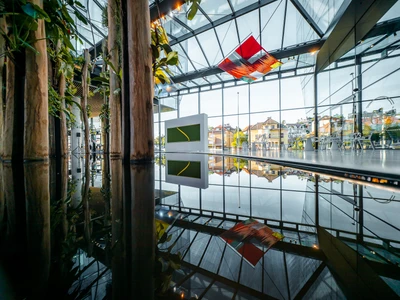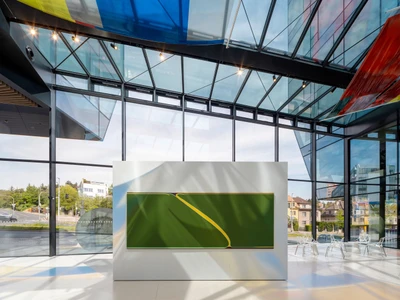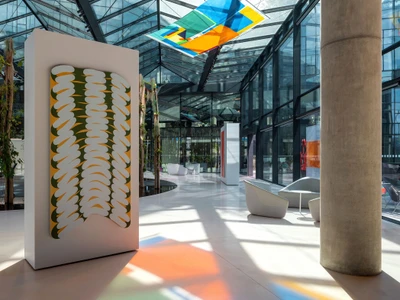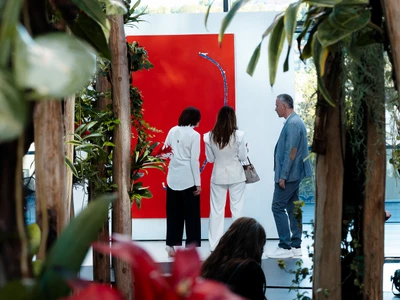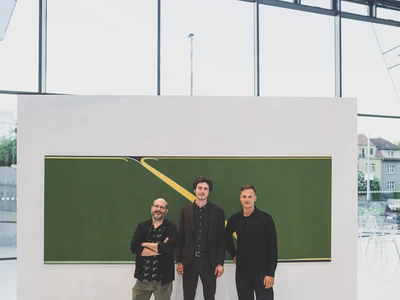M. Moflár, F. Švehla - Anywhere Between Black and White
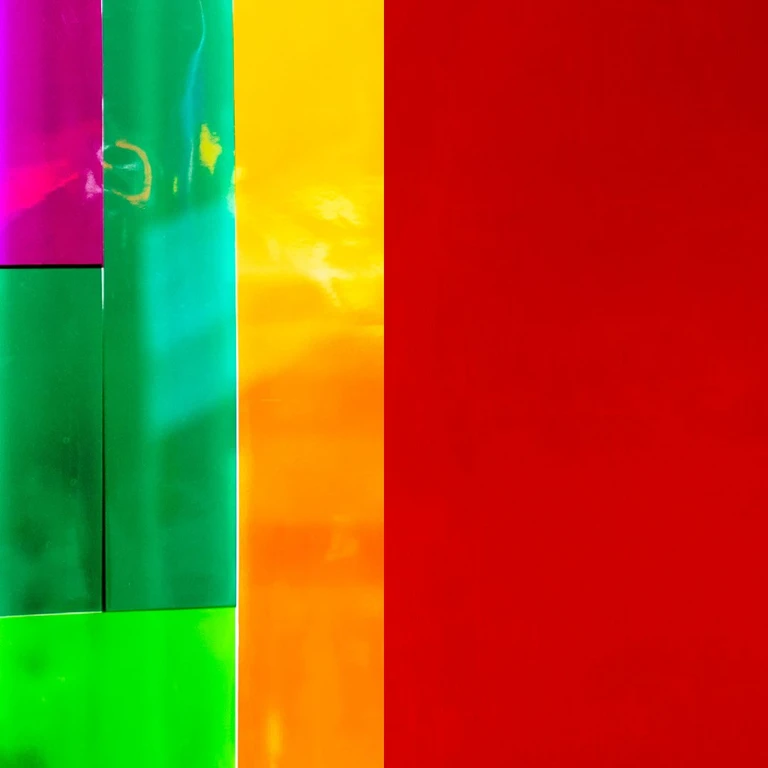
But colors aren't just everyday tools of distinction—they’ve played a major role in innovation and the progress of civilization. Thanks to colorization, we can now vividly reconnect with the past, as old photographs and footage become increasingly lifelike and accessible. Conversely, technologies like satellite thermal imaging or post-processed data from the Webb Telescope help us prepare for a distant future.
This deep engagement with color is the long-term focus of exhibiting artists Martin Moflár and Filip Švehla. Both are fascinated by hues to the point that they detach them from references to real-world objects. They are painters who let color speak in rhythm, shape, curve, and proportion. Though their inspirations often overlap—Mark Rothko, Barnett Newman, Ellsworth Kelly—each artist works with color through a different medium, with distinct foundational approaches.
In his large-format canvases, Martin Moflár composes perfect visual harmony He is known for his disciplined and methodical creative process—one that can take years to complete, from the initial concept through sketches to the final execution. He begins by creating smaller color variations, precisely scaled to the final work, from which he carefully selects. His process also involves working with extensive color samples and incorporating rare and hard-to-find shades made from both synthetic and natural pigments—some of which have not been used in painting for centuries. Moflár often applies these pigments in entirely new ranges and intensities.
Martin Moflár also constructs his own frames, bringing a high level of craftsmanship to each piece. Though his paintings may seem simple, the apparent simplicity conceals the complexity of hand-crafted shapes and deeply considered compositions. It is this commitment to detail throughout the entire process, tested over time, and the resulting simplicity that gives his works their extraordinary presence. On one hand, the colors take on a nearly transcendent quality; on the other, the paintings embody an immanent organic order, where individual color fields respond to one another—expanding, compressing, or shaping themselves according to the forces implied by the lines or contours of the canvas.
Filip Švehla, on the other hand, stands out for his spontaneity. He’s used to traveling and adapting to new cultures. His interest in architecture, space, and urban environments finds expression in abstract compositions of color “mosaics” and gradients. His artistic style is highly variable, shaped by whether he’s just spent a year in Valencia, a holiday in Morocco, or an artist residency in Miami or New York.
For this exhibition, his works intentionally echo the surrounding glass architecture. These are high-hanging collages made of film, which use sunlight to cast shifting images onto the floor. Here, color does not materialize through pigment—it appears in its spectral form, without clear boundaries or permanence. It emerges as suddenly as it disappears, reminding us that we move through color almost constantly, even when we don’t see it, as it is embedded in light itself—in electromagnetic radiation.
Exhibition curator: Jan Čejka
Martin Moflár (b. 1975) is a Slovak artist specializing in monumental abstract painting. His minimalist works explore the balance between color, line, size, and shape. He lives and works in Košice, where he studied in the Studio of Graphics and Experimental Art under Prof. Rudolf Sikora at the Faculty of Arts, Technical University (1999–2005). He has been exhibiting actively since 2006, beginning with Protokompozície at the Municipal Gallery in Rimavská Sobota. In Slovakia, he has also held several solo exhibitions, including Kontemplácia (with Eva Moflárová) at the Bratislava City Gallery – Pálffy Palace (2010), and Martin Moflár – Soft Lines at the East Slovak Gallery in Košice (2023). Among group exhibitions, notable appearances include his participation in the Artbanka Museum of Young Art project in Prague, organized under the patronage of the City Gallery Prague (GHMP), which showcased selected young Czech and Slovak artists (2011 and 2012), and PING-PONG at the House of Arts in Bratislava (2013). Martin Moflár has also maintained a long-term collaboration with the Slovak-American gallery Think+Feel Contemporary, which presented his work at the SCOPE Art Fair in Miami in both 2016 and 2017.
Filip Švehla (b. 1991) is a Czech artist who has long focused on painting, installation, and object-based art. His work explores rhythm, form, and the relationships between colors—often abstracted from real places. Though based in Prague, his practice is marked by an openness to new environments. He attended the Summer Academy in Venice (2017), spent a year living in Valencia after completing his studies (2018), participated in a residency in Miami through the Think+Feel Contemporary gallery (2022), and has made recurring visits to New York, where he gained broader exposure through the Grey Nivas Art Residency (2023). He studied at the Academy of Fine Arts in Prague, passing through several painting studios: the studio of Professor Jiří Sopko (2011–2016), Robert Šalanda’s studio (2016–2017), and a semester in Professor Michael Rittstein’s studio (2014–2015). He also completed a study stay at Hogeschool voor de Kunsten in Utrecht, the Netherlands (2015). In 2017, he received the AVU Studio Award and was a finalist for both the Josef Hlávka Foundation Award (2017) and the Critic’s Prize for Young Painting (2021). Despite his frequent travels, Švehla remains actively engaged in the exhibition scene. Notable projects include Armonico (with Jiří Dolinski) at Gallery OFF/FORMAT in Brno (2019), Today and Tomorrow Will Be Better (with David Minařík) at Pragovka Gallery in Prague (2020), and Gestures of Space (with Julie Kopová) at Curator Contemporary in Prague (2024).
For the exhibition Anywhere Between Black & White, we visited the studios of Martin Moflár in Košice and Filip Švehla in Prague’s Žižkov district. The artists met in Artium for their very first joint exhibition, and we asked them about their creative process, collaboration, inspiration, and above all – what color means to them, as it is the central theme of the entire exhibition. Learn more in the vide
video: Martin Beneš

